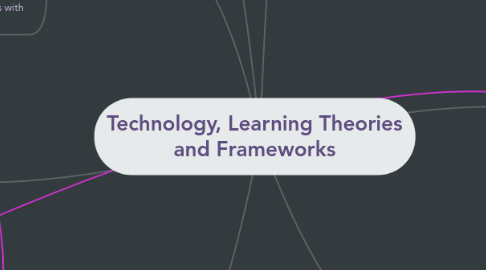Technology, Learning Theories and Frameworks
Door Dana Strauss

1. SCOT
1.1. Social Construction Of Technology
1.2. Suggests that technology is shaped by human action. this is the opposite of media ecology.
1.3. Technologies are developed and redesigned to fit the needs of the people who will be using it.
1.4. Common design features among different products may be seen as the key to their success.
1.5. An example could be the replacement of cassette tapes with CDs.
2. Media Ecology
2.1. The study of technology as an environment that effects humans in their daily lives.
2.2. "The interactions of communications media, technology, technique, and processes with human feeling, thought, value, and behaviour." - Christine Nystrom
3. TPACK
3.1. Three main areas of knowledge
3.1.1. Content Knowledge
3.1.2. Technological Knowledge
3.1.3. Pedagogical Knowledge
3.2. Four intersecting areas of knowledge
3.2.1. Technological Content Knowledge
3.2.2. Pedagogical Content Knowledge
3.2.3. Technological Pedagogical Knowledge
3.2.4. Technological Pedagogical Content Knowledge
3.3. Helps teachers create well developed lessons that are strong in each category of knowledge.
3.4. TPACK Website: www.tpack.org
4. Philosophy of Teachnology
4.1. Is a personal philosophy of teaching including belifes about how technology can and should be used in your teaching practices.
4.2. Can be incorporated into a teacher professional growth plan.
4.3. Can be informed by TPACK
4.4. Can include technology as tools used to compliment or supplement lessons or as a resource in your professional development.
5. Cognitive Load
5.1. Memory is made up of two parts: Working Memory and Long-Term Memory
5.2. Working memory can hold about 7 unrelated pieces of information at one time.
5.3. Long-term memory has an unlimited capacity and stores long term knowledge
5.4. information overoad happens when we try to process too much information in a short ammount of time.
5.5. Teachers need to be careful to avoid information overload in their lessons by limiting how much new information is in each lesson.
5.6. working memory and long term memory work together to create schemas
5.7. information landscapes, chunking and repetition all help students to store new information in long-term memory.
6. Connectivism
6.1. The role of a teacher is to facilitate the development of personal learning networks (PLNs) and connections with knowledge.
6.2. Learning is an ongoing process that requires making connections between fields, ideas and concepts.
6.3. Information is always being updated and knowledge should be current and accurate.
6.4. Learning is a knowledge creation process.
6.5. Learning takes place in a community, network or database rather than in a single person.
7. Constructivism
7.1. People put together or construct their own knowledge.
7.2. The teacher guides or directs the learner towards new information.
7.3. Requires the learner to reflect on past experiences and the way they affect or change their understanding.
7.4. Students gain knowledge about how they learn.
7.5. Learning happens when information or tasks fall within the "Zone of Proximal Development" and the teacher give appropriate help and support.


